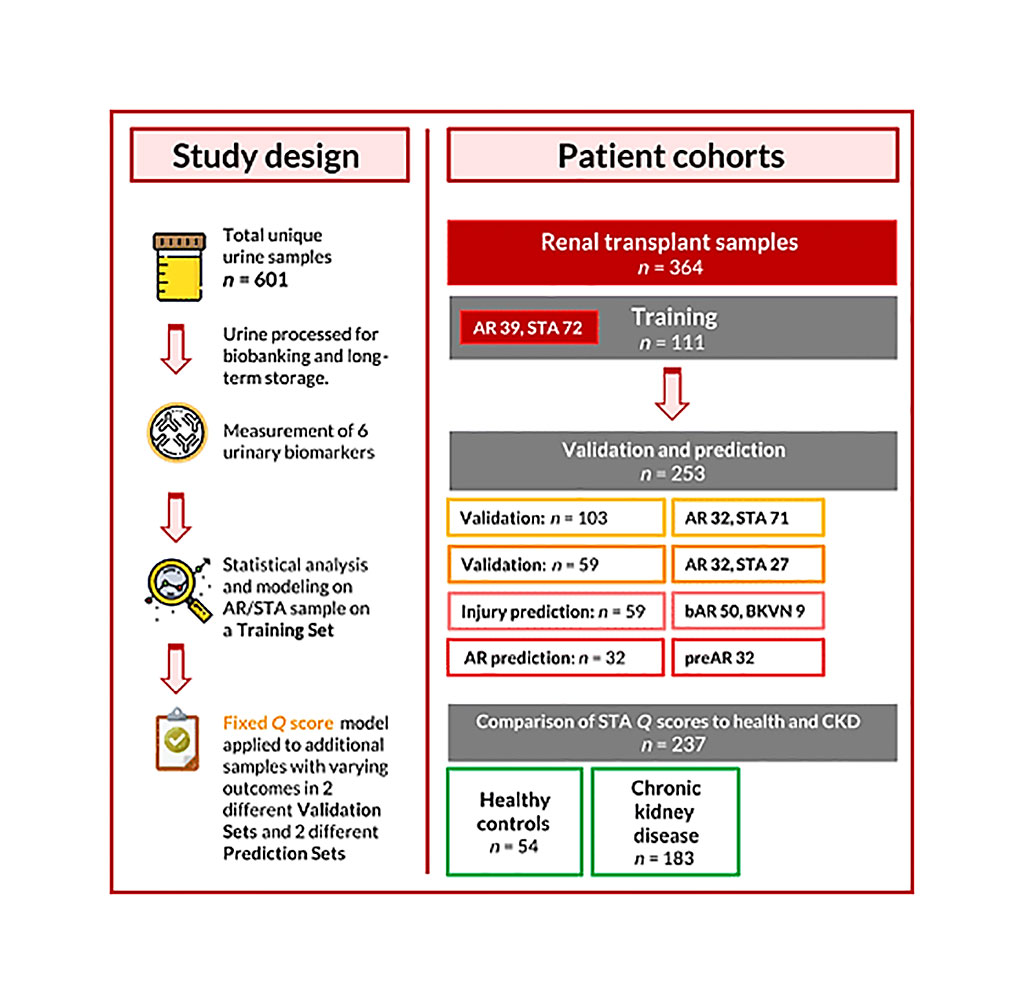Urine-Based Kidney Transplantation Rejection Risk Assay Launched
|
By LabMedica International staff writers Posted on 30 Mar 2020 |

Image: Schematic diagram of a urine score for noninvasive accurate diagnosis and prediction of kidney transplant rejection study (Photo courtesy of the University of California, San Francisco).
For kidney transplant recipients, prompt and accurate detection of transplant rejection is vital for timely intervention. Unfortunately, the gold standard for diagnosis of rejection is kidney biopsy, an invasive procedure.
To diagnose acute rejection in kidney transplant patients, clinicians usually extract several small transplanted kidney samples every few months post-transplant, in addition to measuring the patient's serum creatinine levels. However, kidney biopsies can be invasive and expensive, while serum creatinine levels are often inaccurate and not sensitive enough to detect transplant rejection.
Scientists from the University of California, San Francisco (San Francisco, CA, USA) and their colleagues collected a total of 601 prospective urine samples from both pediatric and adult renal allograft recipients immediately before a renal allograft biopsy. Each sample was then paired with a renal transplant biopsy and classified into the following diagnoses: stable (170); acute rejection (AR, 103); borderline AR (bAR, 50); and BK virus nephropathy (9). The team also collected additional urine samples from 32 patients with AR before the rejection episode and paired them with biopsies.
The team evaluated a noninvasive, spot urine–based diagnostic assay based on measurements of six urinary DNA, protein, and metabolic biomarkers. The team used the QiSant assay (Nephrosant, San Francisco, CA, USA) that analyzes six biomarkers from 4 mL of urine sample: the amount of cell-free DNA (cfDNA); the fraction of methylated cfDNA; the proteins clusterin and creatinine; the inflammation marker CXCL10; and total protein amount in the urine. The assay uses a proprietary enzyme-linked immunosorbent (ELISA)-based tool, including a 5' biotinylated oligonucleated immunoprobe to target cfDNA fragments, and artificial intelligence to estimate the likelihood of acute kidney rejection. After collecting patient samples, the scientists developed a composite Q score — ranging from 0 to 100 — on all six biomarkers in a training set of 39 AR and 72 stable patients (STA).
In the first validation set, which had 32 AR patients and 71 STA patients, the group found that the score between the patient types had about a 91% clinical sensitivity and a 92% clinical specificity. Meanwhile, in a second validation set of 32 AR patients and 27 STA patients, the team found that the scaled score had 100% sensitivity and 96% specificity. Most patients with samples (159) with scores above the AR threshold had a clinical diagnosis of active AR, early AR, or went on to develop biopsy-confirmed AR up to 200 days after using the QiSant assay.
The authors concluded that they had demonstrated the clinical utility of this assay for predicting AR before a rise in the serum creatinine, enabling earlier detection of rejection than currently possible by standard of care tests. This noninvasive, sensitive, and quantitative approach is a robust and informative method for the rapid and routine monitoring of renal allografts. The study was published on March 18, 2020 in the journal Science Translational Medicine.
Related Links:
University of California, San Francisco
Nephrosant
To diagnose acute rejection in kidney transplant patients, clinicians usually extract several small transplanted kidney samples every few months post-transplant, in addition to measuring the patient's serum creatinine levels. However, kidney biopsies can be invasive and expensive, while serum creatinine levels are often inaccurate and not sensitive enough to detect transplant rejection.
Scientists from the University of California, San Francisco (San Francisco, CA, USA) and their colleagues collected a total of 601 prospective urine samples from both pediatric and adult renal allograft recipients immediately before a renal allograft biopsy. Each sample was then paired with a renal transplant biopsy and classified into the following diagnoses: stable (170); acute rejection (AR, 103); borderline AR (bAR, 50); and BK virus nephropathy (9). The team also collected additional urine samples from 32 patients with AR before the rejection episode and paired them with biopsies.
The team evaluated a noninvasive, spot urine–based diagnostic assay based on measurements of six urinary DNA, protein, and metabolic biomarkers. The team used the QiSant assay (Nephrosant, San Francisco, CA, USA) that analyzes six biomarkers from 4 mL of urine sample: the amount of cell-free DNA (cfDNA); the fraction of methylated cfDNA; the proteins clusterin and creatinine; the inflammation marker CXCL10; and total protein amount in the urine. The assay uses a proprietary enzyme-linked immunosorbent (ELISA)-based tool, including a 5' biotinylated oligonucleated immunoprobe to target cfDNA fragments, and artificial intelligence to estimate the likelihood of acute kidney rejection. After collecting patient samples, the scientists developed a composite Q score — ranging from 0 to 100 — on all six biomarkers in a training set of 39 AR and 72 stable patients (STA).
In the first validation set, which had 32 AR patients and 71 STA patients, the group found that the score between the patient types had about a 91% clinical sensitivity and a 92% clinical specificity. Meanwhile, in a second validation set of 32 AR patients and 27 STA patients, the team found that the scaled score had 100% sensitivity and 96% specificity. Most patients with samples (159) with scores above the AR threshold had a clinical diagnosis of active AR, early AR, or went on to develop biopsy-confirmed AR up to 200 days after using the QiSant assay.
The authors concluded that they had demonstrated the clinical utility of this assay for predicting AR before a rise in the serum creatinine, enabling earlier detection of rejection than currently possible by standard of care tests. This noninvasive, sensitive, and quantitative approach is a robust and informative method for the rapid and routine monitoring of renal allografts. The study was published on March 18, 2020 in the journal Science Translational Medicine.
Related Links:
University of California, San Francisco
Nephrosant
Latest Molecular Diagnostics News
- Urine Test Detects Inherited Neuropathy Missed by Genetic Screening
- Genomic Test Predicts Risk of SCC Metastasis
- Microfluidic Device Predicts Pancreatic Cancer Recurrence After Surgery
- New Molecular Test Simultaneously Detects Three Major Fungal Infections
- Blood Test Guides More Effective Ovarian Cancer Treatment
- Liquid Biopsy Test to Enable Earlier Diagnosis of Numerous Cancer Types
- Blood Protein Profile Indicates Early-Onset Coronary Heart Disease
- New DNA Test Tracks Spread of Parasitic Disease from Single Sample
- Hidden Blood Biomarkers to Revolutionize Diagnosis of Diabetic Kidney Disease
- Genetic Testing Trifecta Predicts Risk of Sudden Cardiac Death and Arrhythmia
- Maternal Blood Test Detects Pre-Eclampsia Risk Before Symptoms Develop
- Blood Test Could Assess Concussion Severity in Teenagers with TBI
- Simultaneous Analysis of Three Biomarker Tests Detects Elevated Heart Disease Risk Earlier
- New Biomarker Panel to Improve Heart Failure Diagnosis in Women
- Dual Blood Biomarkers Improve ALS Diagnostic Accuracy
- Automated Test Distinguishes Dengue from Acute Fever-Causing Illnesses In 18 Minutes
Channels
Clinical Chemistry
view channel
Chemical Imaging Probe Could Track and Treat Prostate Cancer
Prostate cancer remains a leading cause of illness and death among men, with many patients eventually developing resistance to standard hormone-blocking therapies. These drugs often lose effectiveness... Read more
Mismatch Between Two Common Kidney Function Tests Indicates Serious Health Problems
Creatinine has long been the standard for measuring kidney filtration, while cystatin C — a protein produced by all human cells — has been recommended as a complementary marker because it is influenced... Read moreMolecular Diagnostics
view channel
Urine Test Detects Inherited Neuropathy Missed by Genetic Screening
Sorbitol dehydrogenase (SORD)-related neuropathy is one of the most common inherited nerve disorders, yet diagnosis often lags because current genetic screens frequently miss the causal gene.... Read more
Genomic Test Predicts Risk of SCC Metastasis
Managing squamous cell carcinoma (SCC) of the skin in patients with one or more risk factors is a significant clinical challenge, especially as SCC-related deaths are now estimated to exceed those from melanoma.... Read moreHematology
view channel
Platelet Activity Blood Test in Middle Age Could Identify Early Alzheimer’s Risk
Early detection of Alzheimer’s disease remains one of the biggest unmet needs in neurology, particularly because the biological changes underlying the disorder begin decades before memory symptoms appear.... Read more
Microvesicles Measurement Could Detect Vascular Injury in Sickle Cell Disease Patients
Assessing disease severity in sickle cell disease (SCD) remains challenging, especially when trying to predict hemolysis, vascular injury, and risk of complications such as vaso-occlusive crises.... Read more
ADLM’s New Coagulation Testing Guidance to Improve Care for Patients on Blood Thinners
Direct oral anticoagulants (DOACs) are one of the most common types of blood thinners. Patients take them to prevent a host of complications that could arise from blood clotting, including stroke, deep... Read moreImmunology
view channel
Chip Captures Cancer Cells from Blood to Help Select Right Breast Cancer Treatment
Ductal carcinoma in situ (DCIS) accounts for about a quarter of all breast cancer cases and generally carries a good prognosis. This non-invasive form of the disease may or may not become life-threatening.... Read more
Blood-Based Liquid Biopsy Model Analyzes Immunotherapy Effectiveness
Immunotherapy has revolutionized cancer care by harnessing the immune system to fight tumors, yet predicting who will benefit remains a major challenge. Many patients undergo costly and taxing treatment... Read moreMicrobiology
view channel
Blood-Based Molecular Signatures to Enable Rapid EPTB Diagnosis
Extrapulmonary tuberculosis (EPTB) remains difficult to diagnose and treat because it spreads beyond the lungs and lacks easily accessible biomarkers. Despite TB infecting 10 million people yearly, the... Read more
15-Minute Blood Test Diagnoses Life-Threatening Infections in Children
Distinguishing minor childhood illnesses from potentially life-threatening infections such as sepsis or meningitis remains a major challenge in emergency care. Traditional tests can take hours, leaving... Read more
High-Throughput Enteric Panels Detect Multiple GI Bacterial Infections from Single Stool Swab Sample
Gastrointestinal (GI) infections are among the most common causes of illness worldwide, leading to over 1.7 million deaths annually and placing a heavy burden on healthcare systems. Conventional diagnostic... Read moreTechnology
view channel
AI Saliva Sensor Enables Early Detection of Head and Neck Cancer
Early detection of head and neck cancer remains difficult because the disease produces few or no symptoms in its earliest stages, and lesions often lie deep within the head or neck, where biopsy or endoscopy... Read more
AI-Powered Biosensor Technology to Enable Breath Test for Lung Cancer Detection
Detecting lung cancer early remains one of the biggest challenges in oncology, largely because current tools are invasive, expensive, or unable to identify the disease in its earliest phases.... Read moreIndustry
view channel
Abbott Acquires Cancer-Screening Company Exact Sciences
Abbott (Abbott Park, IL, USA) has entered into a definitive agreement to acquire Exact Sciences (Madison, WI, USA), enabling it to enter and lead in fast-growing cancer diagnostics segments.... Read more
























